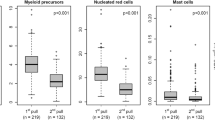Abstract
Daily administration of granulocyte colony-stimulating Factor (G-CSF) results in progenitor cell mobilization with maximum blood levels achieved after 4–7 days. In this study the short-term effects of glycosylated G-CSF at a dose of 5 μg/kg s.c. were determined so as to allow optimization of the timing of progenitor cell collection. In the first study involving 20 normal volunteers, a significant fall in neutrophil count and G-CSF levels was observed 2 h after the G-CSF injection. To investigate this phenomenon serial measurements were made in a further six volunteers after the 6th daily injection of G-CSF. A fall in the neutrophil count occurred which was maximal at 1 h and recovered to baseline within 3 h. There was also a fall in CD34+ cells (P = 0.034), GM-CFC (P = 0.025) and BFU-E (P = 0.066) and recovery to baseline levels took 4–12 h. We conclude that glycosylated G-CSF should not be given immediately prior to stem cell collection.
This is a preview of subscription content, access via your institution
Access options
Subscribe to this journal
Receive 12 print issues and online access
$259.00 per year
only $21.58 per issue
Buy this article
- Purchase on Springer Link
- Instant access to full article PDF
Prices may be subject to local taxes which are calculated during checkout
Similar content being viewed by others
Author information
Authors and Affiliations
Rights and permissions
About this article
Cite this article
Watts, M., Addison, I., Ings, S. et al. Optimal timing for collection of PBPC after glycosylated G-CSF administration. Bone Marrow Transplant 21, 365–368 (1998). https://doi.org/10.1038/sj.bmt.1701099
Received:
Accepted:
Published:
Issue Date:
DOI: https://doi.org/10.1038/sj.bmt.1701099
Keywords
This article is cited by
-
Optimal timing of G-CSF administration for effective autologous stem cell collection
Bone Marrow Transplantation (2011)
-
Hourly monitoring of circulating CD34+ cells to optimize timing of autologous apheresis in pediatric patients
Bone Marrow Transplantation (2005)



